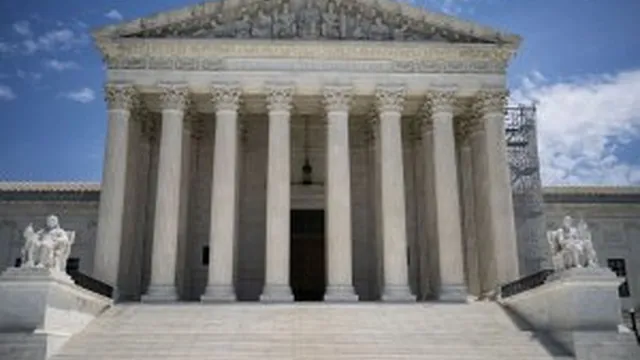
Supreme Court refuses to reconsider Maryland's assault weapons ban
2025-06-02 19:51- The Supreme Court declined to hear a significant challenge to Maryland's assault weapons ban.
- Lower courts upheld the ban, which prohibits the sale and ownership of certain semi-automatic rifles.
- This decision indicates the court's current stance on firearm regulation, leaving existing bans in place.
Express your sentiment!
Insights
On June 2, 2025, the U.S. Supreme Court declined to review a challenge against Maryland's ban on assault weapons, specifically targeting semi-automatic rifles like the AR-15. This decision effectively maintains a previous ruling from the U.S. Court of Appeals for the 4th Circuit, which upheld the legality of Maryland's restrictions that were enacted following the Sandy Hook Elementary School shooting in 2012. The justices' refusal to hear the case means that the law, which restricts the sale and ownership of certain firearms deemed 'dangerous and unusual,' remains in effect. Significantly, this decision comes amid ongoing national debates about the Second Amendment rights and the regulation of firearms. Justices Samuel Alito, Clarence Thomas, and Neil Gorsuch publicly dissented against the court's choice not to take up the appeals, indicating potential divides within the court regarding gun rights and regulations. Justice Brett Kavanaugh remarked that the issue is still under consideration by other federal appeals courts, suggesting that further legal challenges could emerge in the near future. The court's choice not to engage with this issue is especially relevant given its landmark ruling in June 2022, which established a new framework for assessing whether firearm laws align with constitutional rights. Following this ruling, various states have been prompted to pass or defend gun control measures, resulting in a series of appeals flooding the Supreme Court. The Maryland case, representing just one of these appeals, highlights the Court's current reluctance to enter the fray of gun control legal battles, instead opting to wait for more feedback from lower courts. Moreover, the precedent set in the Maryland case reinforces the 4th Circuit's stance that military-style firearms can be regulated without infringing on constitutional rights, reflecting a significant point of contention across the nation. This decision might set a tone for how lower courts approach similar cases in the future, signaling a complex relationship between firearm ownership and public safety. As these discussions unfold, stakeholders from both sides are likely to continue pushing for greater clarity on the Second Amendment and its implications for gun ownership in America.
Contexts
The impact of Supreme Court decisions on gun rights has been a polarizing topic in American legal and political discourse, significantly shaping the landscape of firearm legislation across the nation. The Second Amendment, which protects the right of the people to keep and bear arms, has been interpreted in various ways by the Court. Decisions such as District of Columbia v. Heller (2008) established an individual's right to possess a firearm unconnected with service in a militia for traditionally lawful purposes, such as self-defense within the home. This ruling rolled back many local and state gun control laws, as it asserted that individuals have fundamental rights that cannot be easily infringed upon by government regulation. The ruling has had broad implications for the conversation around gun control and has energized advocacy groups on both sides of the debate — those who champion gun rights and those who seek to impose stricter regulations on firearms. In subsequent years, cases like McDonald v. City of Chicago (2010) further reinforced the interpretations laid out in Heller, applying the Second Amendment to the states through the Fourteenth Amendment. This landmark decision clarified that individual gun ownership rights are not just a federal allowance but also applicable at state and local levels. As a result, numerous firearms restrictions previously upheld by state legislatures have been challenged in courts across the country. The expanding rights to gun ownership have brought about increased scrutiny on how such rulings affect crime rates, gun violence, and public safety, leading to a contentious debate regarding the effectiveness of gun control laws versus the rights granted by the Second Amendment. The Supreme Court's decisions continue to guide the evolution of gun rights specifically, influencing legislation and shaping public perception on gun ownership and usage in America. The Court has been reluctant to take up new cases regarding gun rights in recent years, leading to a patchwork of regulations across the states. Some states have pursued more permissive laws, such as allowing open carry and concealed carry without permits, while others have focused on introducing stricter background checks, waiting periods, and bans on certain firearms and accessories. The aftermath of these rulings has resulted in a dynamic tension between the interpretation of individual rights and community interests in public safety, particularly in the face of increasing concerns about mass shootings and gun-related violence. Looking towards the future, the Supreme Court’s future rulings will likely continue to shape the landscape of gun rights in the United States. As cases challenging existing gun regulations make their way through lower courts, the potential for new interpretations of the Second Amendment remains. This ongoing evolution reflects both societal attitudes towards guns and the interpretive methodologies of the justices. While the Court's historical interpretations have strengthened individual rights, the pressing questions of public safety and the effectiveness of regulations in curtailing violence consistently underscore the conversation surrounding gun rights. As the nation grapples with these challenges, the trajectory of gun rights will undoubtedly remain a central issue in judicial and legislative arenas.